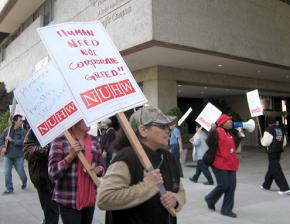Super-profits at a non-profit
reports on ongoing contract fight at California Pacific Medical Center.
CALIFORNIA PACIFIC Medical Center (CPMC) has four medical campuses in San Francisco and is the city's second largest private employer, with 6,000 employees and "over 1,500 doctors and allied health practitioners." Sutter Health, a huge health care provider operating mostly in northern California, owns it.
This vast hospital complex of money and power is actually registered as a "non-profit," meaning it receives lucrative tax perks as long as it upholds its state charter of "serving the public good."
But here is where it gets sticky. CPMC enjoyed over $200 million in profits last year and recorded an astounding 20 percent profit rate. Critics are quick to point out that this is totally out of whack, even for private hospitals, where the national profit rate is 3 percent.
And against this backdrop, Sutter is still demanding concessions from its employees. That's the rub felt by 750 members of the National Union of Healthcare Workers (NUHW).
Helen York has worked 45 years at CPMC as a cashier in food service. She told me, "We have been negotiating over a year, and they are still insisting on reducing our health plan options, eliminating shift pay differential and cutting some of our other benefits that we have enjoyed for decades. Why are they messing with us when they are regularly making such big profits?"

Not so, according to CPMC communications director Kathie Graham, who says:
CPMC is in the middle of contract negotiations with NUHW, which was elected last year...replacing SEIU. While we are committed to taking care of our employees, we also must take steps to make our services more affordable for our patients.
To prepare for the future, we are taking steps throughout the organization to reduce our costs while maintaining or enhancing quality. We have also concluded that our pay and benefits should be simplified and more consistent throughout the organization.
NUHW Vice President John Borsos was quick to respond in my interview:
Referring to wages and benefits being simplified and consistent is a reference to the concessions already conceded by SEIU-UHW before they were ousted by CPMC workers who voted for NUHW last year. In fact, SEIU granted concessions in every single one of its California hospital bargaining negotiations of 2010 and 2012, including at around 10 Sutter hospitals.
To be clear, not one single contract has been settled by SEIU-UHW without concessions; not since the international SEIU took over the local in early 2009 and kicked out the original elected 100-member executive board and dozens of stewards who then became the founding core of NUHW a few months later.
For example, while still representing workers at CPMC, SEIU agreed to remove longstanding, strong job-protection contract language. But at a recent bargaining session, our newly elected member-led team got that "no contracting out" language reinstated. This was a big victory and a strong signal to Sutter that NUHW members have a firm "no-concession" bargaining stance.
SEIU has conceded so regularly in the last several years that hospital management, and not only at Sutter, expects workers to give concessions, even when they are making enormous profits. No way!
NUHW WORKERS conducting an informational picket at CPMC's Pacific campus on October 24 told me that Sutter, traditionally, has been the worst employer in the industry. They pointed to a 60-day strike in 2005 at CPMC as an indication of management intransigence at the bargaining table. Nonetheless, these workers emphasized that SEIU-UHW at the time never agreed to concessions at Sutter or anywhere else.
"This has been our bargaining stance for over 60 years," Borsos added, "since San Francisco General hospital workers formed the nation's first health care union shortly after the 1934 Longshore General Strike.
"Even before Sutter took ownership, CPMC hospitals were the core of militant unionism going back to the 1930s. They were the foundation of the union and were among the first collective bargaining agreements in the country negotiated by the original Local 250 some 60 years ago that regularly set contract standards for other hospitals here and throughout the country."
And, today, Borsos continued, "we have absolutely no interest in going backward, especially when there is no economic justification."
The CPMC medical complex's enormous profits begs the question--how did it make over $200 million last year?
One answer comes from California attorney general Kamala Harris, who recently subpoenaed Sutter Health, CPMC's owner, for possible anti-trust pricing. This isn't the first time.
The August 3, 2006, Sacramento Business Journal reported that "Sutter Health has agreed to settle a class-action lawsuit that alleged price-gouging of patients without insurance, potentially costing the Sacramento-based health system hundreds of millions of dollars."
In addition, Fred Seavey, NUHW research director, informed me that "a San Francisco law firm recently filed a class-action lawsuit on behalf of consumers claiming violations of national and state anti-trust laws where Sutter is alleged to have, once again, unnecessarily boosted prices for consumers."
Sutter has long been plagued by such criticisms, which are compounded by the fact that they have the city's lowest rate of providing charity care to low-income patients.
None of these actions seem consistent with their non-profit status nor, as community health care activists point out, with their medical mission.
So we see at CPMC a clash of two forces, each with their own story. It's never easy to overcome money and power, but history seems to be on the side of NUHW in this case.


